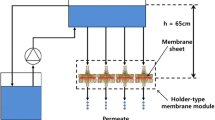Abstract
The formation of a dynamic membrane (DM) was investigated using polyethylene glycol (PEG) (molecular weight of 35000 g/mol, concentration of 1 g/L). Two natural organic matters (NOM), Dongbok Lake NOM (DLNOM) and Suwannee River NOM (SRNOM) were used in the ultrafiltration experiments along with PEG. To evaluate the effects of the DM with PEG on ultrafiltration, various transport experiments were conducted, and the analyses of the NOM in the membrane feed and permeate were performed using high performance size exclusion chromatography, and the effective pore size distribution (effective PSD) and effective molecular weight cut off (effective MWCO) were determined. The advantages of DM formed with PEG can be summarized as follows: (1) PEG interferes with NOM transmission through the ultrafiltration membrane pores by increasing the retention coefficient of NOM in UF membranes, and (2) low removal of NOM by the DM is affected by external factors, such as pressure increases during UF membrane filtration, which decreases the effective PSD and effective MWCO of UF membranes. However, a disadvantage of the DM with PEG was severe flux decline; thus, one must be mindful of both the positive and negative influences of the DM when optimizing the UF performance of the membrane.
Similar content being viewed by others
References
Kuberkar V T, Davis R H. Modeling of fouling reduction by secondary membranes. J Membr Sci, 2000, 168: 243–258
van Oers C W, Vorstman M A G, Kerkhof P J A M. Solute rejection in the presence of a deposited layer during ultrafiltration. J Membr Sci, 1995, 107: 173–192
Tsapiuk E A. Ultrafiltration separation of aqueous solutions of poly (ethylene glycol)s on the dynamic membrane formed by gelatin. J Membr Sci, 1996, 116: 17–29
Zhang M, Li C, Benjamin M M, Chang Y. Fouling and natural organic matter removal in adsorbent/membrane systems for drinking water treatment. Environ Sci Technol, 2003, 37: 1663–1669
Chin Y, Aiken G, O’Loughlin E. Molecular weight, polydispersity, and spectroscopic properties of aquatic humic substances. Environ Sci Technol, 1994, 28: 1853–1858
Her N, Amy G, Park H-R, Song M. Characterizing algogenic organic matter (AOM) and evaluating associated NF membrane fouling. Wat Res, 2004, 38: 1427–1438
Singh S, Khulbe K C, Matsuura T, Ramamurthy P. Membrane characterization by solute transport and atomic force microscopy. J Membr Sci, 1998, 142: 117–127
Tam C M, Tremblay A Y. Membrane pore characterization-comparison between single and multicomponent solute probe techniques. J Membr Sci, 1991, 57: 271–287
Shim Y, Lee H J, Lee S, Moon S H, Cho J. Effects of natural organic matter and ionic species on membrane surface charge. Environ Sci Technol, 2000, 28: 864–871
Wang Y, Combe C, Clark M M. The effects of pH and calcium on the diffusion coefficient of humic acid. J Membr Sci, 2001, 183: 49–60
Thurman E, Malcolm R. Preparative isolation of aquatic humic substances. Environ Sci Technol, 1991, 15: 463–466
Lide D R. Handbook of Chemistry and Physics. 84th ed. New York: Taylor & Francis, 2003–2004, 6–181
Probstein R F. Physicochemical Hydrodynamics. 2nd ed. Hoboken: John Wiley & Sons Inc., 1994
Lee S, Park G, Amy G, Hong S-K, Moon S-H, Lee D-H, Cho J. Determination of membrane pore size distribution using the fractional rejection of nonionic and charged macromolecules. J Membr Sci, 2002, 201: 191–201
Park N, Yoon Y, Moon S-H, Cho J. Evaluation of the performance of tight-UF membranes with respect to NOM removal using effective MWCO, molecular weight, and apparent diffusivity of NOM. Desalination, 2004, 164: 53–62
Jucker G, Clark M M. Adsorption of aquatic humic substances on hydrophobic ultrafiltration membranes. J Membr Sci, 1994, 97: 37–52
Myung S W, Choi I H, Lee S H, Kim I C, Lee K H. Use of fouling resistant nanofiltration and reverse osmosis membranes for dyeing wastewater effluent treatment. Water Sci Technol, 2005, 51(6–7): 159–164
Vrijenhoek E M, Hong S, Elimelech M. Influence of membrane surface properties on initial rate of colloidal fouling of reverse osmosis and nanofiltration membranes. J Membr Sci, 2001, 188: 115–128
Author information
Authors and Affiliations
Corresponding author
Rights and permissions
About this article
Cite this article
Kwon, B., Park, N. & Cho, J. Effects of a dynamic membrane formed with polyethylene glycol on the ultrafiltration of natural organic matter. Front. Environ. Sci. Eng. China 4, 172–182 (2010). https://doi.org/10.1007/s11783-010-0002-y
Received:
Accepted:
Published:
Issue Date:
DOI: https://doi.org/10.1007/s11783-010-0002-y




